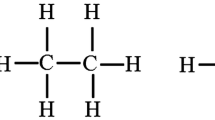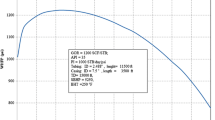Abstract
Asphaltene is one of the important compositions in oil reservoirs, while it is also a major factor that causes difficulties in oil recovery and oil post-processings. Up to date, study on asphaltenes in oil recovery is still a bottleneck problem. In this paper, the advances of studies on asphaltenes are reviewed, and some directions for further studying are suggested. What is reviewed in the paper includes the precipitation studies of asphaltenes, the degradation studies of asphaltenes and the applications of asphaltene’s studying in oil recovery; furthermore, it is regarded as a promising direction to study the possible applications of asphaltene’s selectively decomposing by chemical reagents in oil recovery.
Similar content being viewed by others
References
Speight, J.G., Asphaltenes in crude oil and bitumen: structure and dispersion. Adv. Chem. Ser., 1996, 251 (Suspensions: Fundamentals and Applications in Petroleum Industry): 377.
Mansoori, G.A., Modeling of asphaltene and other heavy organic depositions, Journal of Petroleum Science and Engineering, 1997, 17: 101.
Hirschberg, A., The role of asphaltenes in compositional grading of a reservoir’s fluid column, SPE Paper No. 13171, 1984.
Hirschberg, A., De Jong, L.N.J., Schipper, B.A. et al., Influence of temperature and pressure on asphaltene flocculation, SPE 11202, 1984, 283.
Park, S.J., Mansoori, G.A., Aggregation and deposition of heavy organics in petroleum crudes, Energy Sources, 1988, 10: 109.
Wilhelms, A., Larter, S.R., Origin of tar-mats in petroleum reservoirs, Part I: introduction and case studies, Marine and Petroleum Geology, 1994, 11(4): 418.
Wilhelms, A., Larter, S.R., Origin of tar-mats in petroleum reservoirs, Part II: formation mechanisms for tar-mats, Marine and Petroleum Geology, 1994, 11(4): 442.
Larter, S.R., Aplin, A.C., Reservior geochemistry: methods, applications and opportunities, The Geochemistry of Reserviors, Geological Society Special Publication No. 86, 1995, 5.
Wilhelms, A., Larter, S.R., Overview of the geochemistry of some tar-mats from the North Sea and USA: implications for tar-mat origin, The Geochemistry of Reserviors, Geological Society Special Publication No. 86, 1995, 87.
Pernyeszi, T., Patzko, A., Berkesi, O. et al., Asphaltene adsorption on clays and crude oil reservoir rocks, Colloids and Surfaces A: Physicochemical and Engineering Aspects, 1998, 137: 373.
Tissol, B.P., The geochemistry of resins and asphaltenes, Characterization of Heavy Crude Oils and Petroleum Residues (in Chinese), Beijing: Petroleum Industry Press, 1989, 2.
Speight, J.G., Long, R.B., The concept of asphaltenes revisited, Fuel Science and Technology Int’ L., 1996, 14(1& 2): 1.
Storm, D. A., Sheu, E.Y., Characterization of colloidal asphaltenic particles in heavy oil, Fuel, 1995, 74(8): 1140.
Leontaritis, K.J., The asphaltene and wax deposition envelopes, Fuel Science and Technology Int’ L., 1996, 14(1& 2): 13.
Yang Zhao, Guo Tianmin, The review of studies on asphaltene’s precipitation, Petroleum Exploration and Development (in Chinese), 1997, 24(5): 98.
Mannistu, K.D., Yarranton, H.W., Masliyah, J.H., Solubility modeling of asphaltenes in organic solvents, Energy & Fuels, 1997, 11: 615.
Storm, D.A., DeCanio, S.J., DeTar, M.M. et al., Upper bound on number average molecular weight of asphaltenes, Fuel, 1990, 69(6): 735.
Liu, Y.C., Sheu, E.Y., Chent, S.H. et al., Fractal structure of asphaltenes in toluene, Fuel, 1995, 74(9): 1352.
Xu Yingnian, Yoshikata Koga, Strausz, O.P., Characterization of Athabasca asphaltenes by small-angle X-ray scattering, Fuel, 1995, 74(7): 960.
Bardon, Ch., Barre, L., Espinat, D. et al., The colloidal structure of crude oils and suspensions of asphaltenes and resins, Fuel Science and Technology Int L., 1996, 14(I & 2): 203.
Sheu, E.Y., Storm, D.A., Shields, M.B., Adsorption kinetics of asphaltenes at toluene/acid solution interface, Fuel, 1995, 74(10): 1475.
Tojima, M., Suhara, S., Imamura, M. et al., Effect of heavy asphaltene on stability of residual oil, International Symposium on Advances in Catalysis and Processes for Heavy Oil Conversion, Presented before the Division of Petroleum Chemistry, Inc. 213th National Meeting, American Chemical Society, San Francisco, CA, April 13–17, 1997, 504.
Storm, D.A., Barresi, R.J., De Canio, S.J., Colloidal nature of vacuum residue, Fuel, 1991, 70(6): 779.
Laux, H., Rahimian, I., Boundaries of colloid stability of crude oils, Erdöl, Erdgas und Kohle, 1998, 114(1): 25.
Victorov, A.I., Firoozabadi, A., Thermodynamic micellization model of asphaltene precipitation from petroleum fluids, AIChE Journal, 1996, 42(6): 1753.
Chang Chia-Lu, Fogler, H.S., Peptizalion and coagulation of asphaltenes in a polar media using oil-soluble polymers, Fuel Science and Technology Int L. 1996, 14(1& 2): 75.
Fotland, P., Anfindsen, H., Electrical conductivity of asphaltenes in organic solvents, Fuel Science and Technology Int’L. 1996, 14(1& 2): 101.
Fotland, P., Precipitation of asphaltenes at high pressures: experimental technique and results, Fuel Science and Technology Int L. 1996, 14(1& 2): 313.
Taylor, S.E., The electrodeposition of asphaltenes and implications for asphaltene structure and stability in crude and residual oils, Fuel, 1998, 77(8): 821.
Yutaka Koinuma, Satoshi Kushiyama, Reiji Aizawa et al., Distribution of heteroatoms in asphaltenes separated from Khafji residue before and after hydrotreatment as studied by GPC fractionation, International Symposium on Advances in Catalysis and Processes for Heavy Oil Conversion, Presented before the Division of Petroleum Chemistr, Inc. 213th National Meeting, American Chemical Society, San Francisco, CA, April 13–17, 1997, 331.
Andersen, S.I., Stenby, E.H., Thermodynamics of asphaltene precipitation and dissolution investigation of temperature and solvent effects, Fuel Science and Technology Int’L. 1996, 14(1& 2): 261.
MacMillan, D.J., Tackeff Jr., J.E., Jessee, M.A. et al., A unified approach to asphaltene precipitation: laboratory measurement and modeling, JPT, 1995, 9: 788.
Buckley, J.S., Microscopic investigation of the onset of asphaltene precipitation. Fuel Science and Technology Int’L. 1996, I4(1& 2): 55.
Storm, D.A., Sheu, E.Y., Flocculation of asphaltenes in heavy oil at elevated temperatures, Fuel Science and Technology Int’L. 1996, 14(1& 2): 243.
Clarke, P.F., Pruden, B.B., The development of an onset-of-precipitation detection technique using heat transfer analysis, Fuel Science and Technology Int’L. 1996, 14(1& 2): 117.
Clarke, P.F., Pruden, B.B., Asphallene precipitation: detection using heat transfer analysis, and inhibition using chemical additives, Fuel, 1997, 76(7): 607.
Laux, H., Kopsch, H., Rahimian, I., About formation of coke in the cracking of crude oil residues (3)-modelling. Erdöl, Erdgas und Kohle, 1996, 112(7/8): 319.
Matthew Neurock, Klein, M.N., Molecular reaction modelling of the thermal pathways and kinetics of heavy hydrocarbon systems, Symposium on Petroleum Chemistry and Processing, Presented before the Division of Petroleum Chemistry, Inc. 210th National Meeting, American Chemical Society. Chicago, IL, August 20–25, 1995, 700–704.
Michels, R., Langlois, E., Ruau, O. et al., Evolution of asphaltenes during artificial maturation: a record of the chemical processes, Energy & Fuels, 1996, 10: 39.
Wilhelms, A., Larter, S.R., Characterization of asphaltenes by pyrolysis-field ionization mass spectrometry some observations, Org. Geochem., 1993, 20(7): 1049.
Delvaux, D., Martin, H., Leplat, P. et al., Comparative Rock-Eval pyrolysis as an improved tool for sedimentary organic matter analysis, Org. Geochem. 1990, 16(4–6): 1221.
Tissot, B.P., Pelet, R., Ungerer, P.H., Thermal history of sedimentary basins, maturation indices, and kinetics of oil and gas generation, The American Association of Petroleum Geologists Bulletin, 1987, 71(12): 1445.
Primio, R.D., Horsfield, B., Predicting the generation of heavy oils in carbonate/evaporitic environments using pyrolysis methods, Org. Geochem., 1996, 24(10/11): 999.
Peng Yusheng, Ji Huasheng, Liang Chunxiu, The Custody Studies on Microbial Enhanced Oil Recovery (in Chinese) Beijing: Petroleum Industry Press, 1997, 9: 258.
Donaldson, E.C., Chilingarian, G.V., Yen, T.F., Microbial Enhanced Oil Recovery (in Chinese), Beijing: Petroleum Industry Press, 1995, 4, 143.
Yu Qitai, The strategy and method or enhanced oil recovery, Atta. Petrolei Sinica (in Chinese), 1996, 17(2): 53.
Donaldson, E.C., Chilingarian, G.V., Yen, T.F., Enhanced Oil Recovery, II: Processes and Operations (in Chinese), Beijing: Petroleum Industry Press, 1992, 1: 379.
Surguchev, M.L., The Means of Secondary and Tertiary Enhanced Oil Recovery (in Chinese), Beijing: Petroleum Industry Press, 1993, 12: 182.
Ekweozor, C.M., Characterization of the non-asphaltene products of mild chemical degradation of asphaltenes, Org. Geochem., 1986, 10: 1053.
Butler, R.M., Thermal Recovery of Oil and Bitumen (in Chinese), Beijing: Petroleum Industry Press, 1994, 9: 312.
Gorbunov, A.T., Bucheikov, L.N., The Alkaline Water Drive (in Chinese), Beijing: Petroleum Industry Press, 1995, 1: 207.
Wang Yunfeng, Zhang Chun’guang, Hou Wan’guo et al., The Surfactants and Their Applications in Oil-gas Fields (in Chinese), Beijing: Petroleum Industry Press, 1995, 6: 293.
Littmann, W., Polymer Flooding (in Chinese), Beijing: Peroieum Industry Press, 1991, 8: 107.
Economides, M.J., Nolte, K.G., Technologies of Enhanced Oil Recovery (in Chinese), Beijing: Petroleum Industry Press, 1991, 12: 376.
Author information
Authors and Affiliations
Corresponding author
About this article
Cite this article
Liao, Z., Geng, A. Asphaltenes in oil reservior recovery. Chin.Sci.Bull. 45, 682–688 (2000). https://doi.org/10.1007/BF02886171
Received:
Issue Date:
DOI: https://doi.org/10.1007/BF02886171




